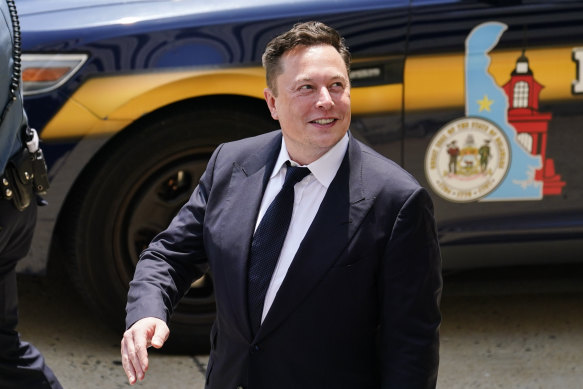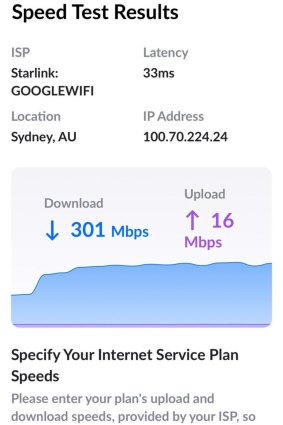This was published 3 years ago
Musk’s stargazing could move dial on Australia’s regional internet problem
By Zoe Samios
The space escapades of billionaire Elon Musk may be fascinating to watch, but they could also deliver a crucial solution to a pain point for regional communities.
Musk, co-founder of $1.3 trillion Tesla and rocket company SpaceX, has been quietly rolling out his satellite internet service Starlink in Australia since April. And while the billionaire’s new program is still in beta phase, it is already showing signs it could deliver internet at speeds significantly faster than the NBN.

Tesla has made Elon Musk the world’s richest person. But it is his exploration company Space X that could change the world’s internet coveage.Credit: AP
Michael Tiyce, who runs family law firm Tiyce & Lawyers, was using NBN’s Sky Muster satellite at his farm in the Southern Highlands in NSW but found he was quickly running out of data because he was using the internet to work from home. So he switched to Starlink.
“It’s an entirely different world,” Tiyce says. “We went from having to ration Foxtel, and we couldn’t stream. Now you have anything downloading, Spotify playing, sit on a Zoom and there’s no latency whatsoever.
“A sleet storm, light hail, winds, beautiful sunny days - it’s just been perfect.”
Starlink, which provides internet using low orbit satellite constellations, is charging users $139 per month for an internet plan that promises speeds of between 50 Mbps and 150 Mbps. Due to the low number of people using the service, speeds currently available are between 200 Mbps to 320 Mbps.
‘When people catch on to it, people will leave the NBN in droves.’
Michael Tiyce, lawyer
The self-configuring satellite costs $709 and a further $100 for shipping and handling. While standard installation of NBN’s Sky Muster satellite is free, it promises speeds of 12 Mbps for the basic service and 25 Mbps for the Sky Muster plus service. Starlink’s beta program also has no cap on data. Screenshots provided to this masthead show a download speed of 301 Mbps and an upload speed of 16 Mbps for Ticye and his partner.
“We sound a bit ‘culty’, but we are a litigation firm and when you can’t hear what the judge says or what your client say - it was life-changing,” Ticye says. “When people catch on to it, people will leave the NBN in droves.”
Starlink is not available everywhere in Australia. It is currently available in parts of Victoria and Southern NSW, but is taking orders from people in other regional areas.
It has even attracted attention from former NBN board member and Internode founder, Simon Hackett. “Starlink is pretty darned impressive,” he wrote on October 22 alongside a picture that showed download speeds of 314 Mbps.

Michael Tiyce’s Starlink satellite dish in the Southern Highlands.
Brian Holder, who owns a farm near Braidwood in NSW and is general of sales and marketing at IT company Tecala Group, was struggling to run video meetings from his property where he spent most COVID-19 related lockdowns.
“Trying to work from home in a standard modern workplace environment was permanently sub-optimal and sometimes unworkable,” Holder says. “At one point I was presenting to the board and my service deteriorated to such a degree that I just dropped off the call. That was a low point.”
Holder says he expects the speeds to slow slightly when more people join the service, but that it will still be better than anything currently available.
“Right now when I connect my laptop directly via ethernet to the modem, I’ve seen 230 Mbps and more. On Wi-Fi, I’m averaging around 170 Mbps depending on how far I am from the modem. Bear in mind it’s in beta test at the moment - so there’s low traffic - it’s like driving a really fast car on an empty freeway.
“My ADSL averaged 2 Mbps. Even if increased traffic was to slow it by a factor of 10, it’s still going to 10 times better than I had.”
Damian* also owns a property near Braidwood and was using ADSL until he bought a Starlink satellite. He refused to pay for NBN’s Sky Muster Satellite because the plan was expensive and the results were sketchy. “I turned on my internet and instantly was getting speeds of over 200 gigabits per minute,” he says. “The user experience is world’s apart - you don’t deal with a call centre.
“You look at the Australian government, the NBN, Telstra - all their resources. It’s clumsy, and it’s complicated and at the end of the day, the services are crap. Compared to this, it just doesn’t make sense.”
It isn’t just commercial users that are interested in this service - the NSW Police became the first enterprise customer for Starlink in May.

A speed test of the internet from a Starlink device.
The reason why the internet speeds offered by Starlink are so fast is because of the satellites they use. NBN Co uses two satellites that sit 36,000 kilometres from the earth and rotate in line with the planet.
But Starlink, through its parent company SpaceX, has 1740 satellites and Musk has plans to eventually launch up to 40,000. These are known as low earth orbit (LEO satellites) and sit about 300 km from earth. They are being deployed by Amazon and OneWeb, but Musk’s are the first to be rolled out in Australia.
Musk’s satellites only work with ground stations that allow them to connect into the broader internet. The NBN has 10 ground stations, but Starlink is likely to have dozens because the satellites are at a lower orbit and have a smaller field of view. Starlink has also launched in New Zealand with reports pointing to Vocus Group, owner of Dodo and iPrimus, as the telco behind the creation of the ground stations.
What this means for the NBN’s satellite service remains to be seen. The pricing and speeds of Starlink could change once the beta test is concluded and be too expensive for the average user. But all signs point to competition for the NBN.
The federal government has invested billions trying to solve problems with poor connectivity across Australia’s vast landscape, with NBN’s regional networks to swell to a net loss of almost $10 billion over their lifetimes. Of the 416,378 “ready to connect” satellite households, just 112,879 premises are connected. But it’s not just the NBN rollout that has cost taxpayers. The government has announced almost $280 million in funding as part of its regional connectivity program. Meanwhile, the regional broadband scheme levies industry to subsidise the cost of NBN’s loss.
For his part, Communications Minister Paul Fletcher welcomes the competition.
“The NBN is one network among many,” Fletcher says. “The Morrison government does not want the NBN to be the only provider servicing Australia. That was Labor’s mindset; we prefer competition.
“The NBN is reliably serving the needs of millions of Australians and will continue to do so; but we want to see the maximum degree of choice and optionality. Whether it is 5G, fixed wireless broadband, or low earth orbiting satellite providers such as Starlink, the more choices of communication networks there are for regional and rural Australians, the better.”
As always, no plan is perfect. David Kennedy, managing director at consultancy Venture Insights, says Starlink will have an impact, but the price of installation could be too much for some.
“The basic problem with Starlink is the price,” says Kennedy, who as an NBN Sky Muster Plus service. “[It’s] a lot more than NBN, and we know that consumers are reluctant to bear upfront costs. At $139 per month, the monthly cost is high too. In exchange, you get higher speeds and lower latency than NBN plus unlimited data, but you have to pay a lot to get them.
“What could turn this around is if Starlink cut the price of the installation. But until that happens, I think they’ll have a marginal impact.”
The proliferation of the LEOs also comes with global risk - everything from cybersecurity vulnerabilities to bright lights that clutter the night sky and make it difficult to see the stars.

A string of SpaceX StarLink satellites passes over an old stone house near Florence, Kan. The train of lights was actually a series of relatively low-flying satellites launched by Elon Musk’s SpaceX as part of its Starlink internet service.Credit: AP
A paper presented at the 70th International Astronautical Congress in 2019 said that while these satellites will transform the availability of internet across the globe, there will also be unintended consequences such as increases in cyberattacks through the proliferation of lasers that are capable of disrupting satellite communications.
For its part, the NBN says its services are well positioned against the LEOs and believes there will be continued demand for its service as products like Starlink launch.
“The NBN Sky Muster satellite network is a crucial part of NBN Co’s national broadband infrastructure,” a spokesman said.
“NBN Co’s satellite services are competitively priced and well positioned against the LEO satellite services. NBN Co is currently investing more than $200 million per year in fixed wireless and satellite to meet current and future customer needs.”
*Damian is a pseudonym. The user requested anonymity to speak with this masthead.
The Business Briefing newsletter delivers major stories, exclusive coverage and expert opinion. Sign up to get it every weekday morning.